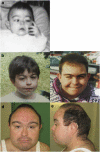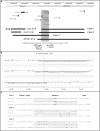Genotype-phenotype relationship in three cases with overlapping 19p13.12 microdeletions
- PMID: 20648052
- PMCID: PMC3002847
- DOI: 10.1038/ejhg.2010.115
Genotype-phenotype relationship in three cases with overlapping 19p13.12 microdeletions
Abstract
We describe the detailed clinical and molecular characterization of three patients (aged 7, 8(4/12) and 31 years) with overlapping microdeletions in 19p13.12, extending to 19p13.13 in two cases. The patients share the following clinical features with a recently reported 10-year-old girl with a 19p13.12 microdeletion: mental retardation (MR), psychomotor and language delay, hearing impairment, brachycephaly, anteverted nares and ear malformations. All patients share a 359-kb deleted region in 19p13.12 harboring six genes (LPHN1, DDX39, CD97, PKN1, PTGER1 and GIPC1), several of which may be MR candidates because of their function and expression pattern. LPHN1 and PKN1 are the most appealing; LPHN1 for its interaction with Shank family proteins, and PKN1 because it is involved in a variety of functions in neurons, including cytoskeletal organization. Haploinsufficiency of GIPC1 may contribute to hearing impairment for its interaction with myosin VI. A behavioral phenotype was observed in all three patients; it was characterized by overactive disorder associated with MR and stereotyped movements (ICD10) in one patient and hyperactivity in the other two. As Ptger1-null mice show behavioral inhibition and impulsive aggression with defective social interaction, PTGER1 haploinsufficiency may be responsible for the behavioral traits observed in these patients.
Figures



References
-
- Engels H, Brockschmidt A, Hoischen A, et al. DNA microarray analysis identifies candidate regions and genes in unexplained mental retardation. Neurology. 2007;68:743–750. - PubMed
-
- Aten E, den Hollander N, Ruivenkamp C, et al. Split hand-foot malformation, tetralogy of Fallot, mental retardation and a 1 Mb 19p deletion-evidence for further heterogeneity. Am J Med Genet A. 2009;149A:975–981. - PubMed
-
- Lysy PA, Ravoet M, Wustefeld S, et al. A new case of syndromic craniosynostosis with cryptic 19p13.2-p13.13 deletion. Am J Med Genet A. 2009;149A:2564–2568. - PubMed
-
- Auvin S, Holder-Espinasse M, Lamblin MD, Andrieux J. Array-CGH detection of a de novo 0.7-Mb deletion in 19p13.13 including CACNA1A associated with mental retardation and epilepsy with infantile spasms. Epilepsia. 2009;50:2501–2503. - PubMed
Publication types
MeSH terms
LinkOut - more resources
Full Text Sources
Medical
Molecular Biology Databases
Research Materials
Miscellaneous

